Mildura, Victoria
| Mildura Victoria |
|||||||
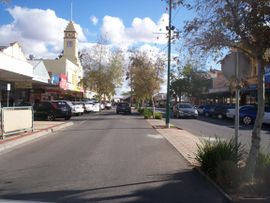 Langtree Avenue, Mildura |
|||||||
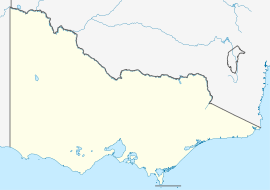 Mildura
|
|||||||
| Population: | 30,016 (2006)[1] | ||||||
| Established: | 1887 | ||||||
| Elevation: | 50 m (164 ft) | ||||||
| Time zone:
• Summer (DST) |
AEST (UTC+10)
AEST (UTC+11) |
||||||
| Location: | |||||||
| LGA: | Rural City of Mildura | ||||||
| Region: | Sunraysia | ||||||
| State District: | Mildura | ||||||
| Federal Division: | Mallee | ||||||
|
|||||||
Mildura is a regional city in northwestern Victoria, Australia, part of the Rural City of Mildura. Mildura is located in the Sunraysia region, and is on the banks of the Murray River. The city's population was 30,016 at the 2006 census.[1]
Mildura is also known as the centre of Victoria's Food Bowl and is a major producer of citrus fruits (especially oranges), and wine. It is also notable for its grape production, supplying 80% of Victoria's grapes [2]. Many wineries also source grapes from Mildura.
Contents |
History
Many Aboriginal people lived around the site of Mildura because of the abundant food. Local tribes included the Latje Latje and Yerre Yerre. Europeans noticed this abundance and decided to harness it, so they brought sheep to graze the natural pastures.
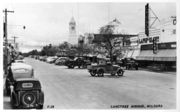
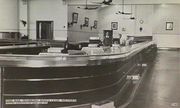
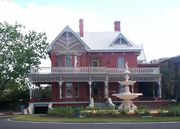
Irrigation settlement
A major drought in Victoria from 1877 to 1884 prompted Alfred Deakin, then a minister in the State Government and chairman of a Royal Commission on water supply to visit the irrigation areas of California. There he met George and William Chaffey.
In 1886 George Chaffey came to Australia and selected a derelict sheep station at Mildura as the site for his first irrigation settlement signing an agreement with the Victorian government to spend at least £300,000 on permanent improvements at Mildura in the next twenty years.[3]
After much political wrangling, the settlement of Mildura was established in 1887. It was named after the Mildura sheep station that provided most of the land. The name is of Aboriginal origin, and means either "red sand" or "sore eyes" [4]. The Post Office opened on January 23, 1888.[5]
Growth
The nearby towns of Wentworth, Gol Gol, Curlwaa and Yelta sprang up in the mid to late 1800s. In the 1890s came the scourge of the rabbit. This devastated the sheep farmers, especially south of the Murray. There was also a financial recession at this time. Combined, these factors restricted growth of the new settlement.
After this period, the new settlement grew and grew. It was soon the main town of the district. Suburbs and new satellite towns sprang up. From the 1920s, a number of 'suburban' train services were established to Merbein and Red Cliffs[6]. These were operated by Rail Motors. In 1934 it officially became a city [4].
Climate
Mildura enjoys a mostly warm climate. It is only about 50 metres above sea level despite being several hundred kilometres from the coast.[4] Mildura is classified as a semi-arid climate (Koppen climate classification BSk) and as a result, is surrounded by semi-desert once outside the city limits.
Rainfall totals are about 280 mm a year and are spread evenly across the months and seasons with Winter and Spring having the most rainy days.[7]
Average maximum temperatures range from a hot 32 °C (90 °F) in summer to 15 °C (59 °F) in winter. Minimum temperatures range from around 17 °C (63 °F) in summer to 4 °C (39 °F) in winter[8], when frost is common and often destructive to irrigated crops. Mildura experiences some very hot days in summer with temperatures exceeding 40ºC (104ºF) on a number of days per year.[7] Mildura is typically the warmest area in Victoria on most days.
| Climate data for Mildura | |||||||||||||
|---|---|---|---|---|---|---|---|---|---|---|---|---|---|
| Month | Jan | Feb | Mar | Apr | May | Jun | Jul | Aug | Sep | Oct | Nov | Dec | Year |
| Source: [8] | |||||||||||||
Culture
Mildura is host to many annual festivals such as the Mildura Country Music Festival, the International Balloon Fiesta, the Jazz Food & Wine Festival, Mildura Wentworth Arts Festival, Murray River International Music Festival, Mildura Writers Festival, Mildura Palimpsest and the Mildura Show [4]. there is also the annual Mildura masters coarse fishing competition held in November which attracts a number of international and local coarse anglers
Demographics
As of the 2006 Census, there were 30,016 people residing in 13,053 households. 82.8 % of Mildura residents are Australian born. Of those born overseas: England (1.5%), Italy (1.4%), Turkey (1.4%), New Zealand (1.1%), Greece (0.5%). English is the only language spoken at home for 86.2% of households.[1]
Media
Local newspapers include the Sunraysia Daily, Mildura Midweek, Mildura Weekly and the Mildura Independent Star which ceased publication in 2007. Local radio stations include ABC Local Radio, Easymix 1467AM (3ML), 97.9 3MA FM, 99.5 Star FM, and Hot FM.
Local TV stations include ABC Television, SBS Television, Prime Television, WIN Television & Ten Mildura. WIN Mildura broadcasts the programming from the Nine Network, while the some programming from Network Ten. The Sunraysia region, including the city of Mildura, was the first region in Australia to switch off analogue TV broadcast in the implementation of the country's DTV transition process.[9]
Sport
Mildura has three Australian Rules football teams competing in the Sunraysia Football League; Imperials, Mildura and South Mildura.[10]
Mildura has a horse racing club, the Mildura Racing Club, which schedules around nine race meetings a year including the Mildura Cup meeting in May.[11]
Mildura Harness Racing Club conducts regular meetings at its racetrack in the city. [12]
Golfers play at the course of the Mildura Golf Club on Twelfth Street.[13] there are also 5 baseball clubs; Hawks, Saints, Eagles, tigers, and wanderers
Basketball also has a large following in Mildura with hundreds of teams in all divisions entered in the Mildura Basketball Association's summer league.
Association football also has a large following in Mildura, with there being a popular junior and senior league played during the winter months. The league consists of six teams, those being Three Colours, Mildura City, Mildura United, Irymple Knights, Cosmos and Nichols Point
Mildura is a very motor sports oriented town. It has several tracks in the region to cater for different types of motor sports:
- Mildura Kart Club – Go-Kart racing
- Timmis Speedway – Automobile speedway
- Olympic Park Speedway – Motorcycle speedway
- Sunset Strip – 1/8th mile drag racing
- North West Victoria Motorcycle Club – Off road motorcycle racing
Transport
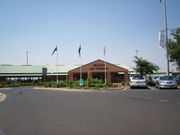
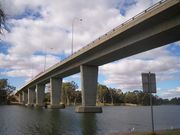
Mildura is on the intersection of the Sturt Highway from Adelaide to Sydney, and the Calder Highway to Melbourne via Bendigo.
Mildura has a railway connection to Melbourne, which is used for freight transport. In May 2006, it was announced that the Mildura line would receive a $73 million upgrade using gauge convertible sleepers.[14]
Sunraysia Bus Lines, Swan Hill Bus Lines and Dysons Bus Services operate V/Line bus/train services that connect Mildura to various parts of Victoria and southern NSW. Greyhound Australia run buses to Adelaide and Sydney via Canberra. Countrylink run buses to Sydney. The Henty Highway Bus Service runs buses to Horsham.
Mildura Airport is the third busiest airport in Victoria, serviced by four QantasLink flights daily to Melbourne, four Regional Express flights to Melbourne, and two Sharp Airlines flights daily to Adelaide. Virgin Blue has one flight per day in each direction between Melbourne and Mildura.
Deakin Avenue, the main street of Mildura, is known as the longest straight avenue in Australia, at 12.1 km [4].
Fruit Fly Exclusion Zone
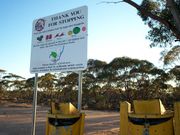
Mildura is part of the 'Fruit Fly Exclusion Zone', in which fruits or vegetables may not be taken into the area (they can, however, be taken out). This is to stop the fruit fly from invading crops and plantations. Disposal bins into which fruit can be disposed of are located along highways entering the zone.
Visitor attractions
- Murray River
- Mildura International Balloon Fiesta
- Australian Inland Botanic Gardens, located nearby in Mourquong
- Various Arts Festivals
- Australian Alternative Varieties Wine Show
Education
La Trobe University
La Trobe University operates a regional campus in Mildura, with 322 students enrolled as of 28 May 2008[15].
Nowingi toxic waste proposal
In 2004 there was a controversial proposal by the Victorian Government to build a state-level Long Term Containment Facility (LTCF) for Industrial Waste in Nowingi, approximately 50 km south of Mildura. The site is a small enclave of state forest surrounded by national park, and contains habitat important to a number of threatened species.
Its hydrological composition was disputed, the Environmental Effects Statement (EES) investigations and subsequent evidence predicted that contaminated moisture would take greater than 1000 years to move though the LTCF barrier system. Transport modelling of groundwater contaminants predicted that if contaminants did enter the groundwater, they would move slowly through the Blanchetown Clay and then in a westerly to north-westerly direction towards the Raak Plains, taking thousands of years to finally discharge within the Raak Boinkas in the Murray-Sunset National Park, while local opponents claimed it would flow east through Hattah-Kulkyne National Park into the Murray River.
The site was going to be around 500 km away from Melbourne, where most of the waste is generated. Local opponents to the LTCF argued that transporting the waste would have incurred higher costs and create more opportunity for accident than a LTCF closer to Melbourne.
Local opponents, a group called "Save the Food Bowl Alliance" and local media branded the LTCF the "Mallee Toxic Waste Dump". The chairman of the "Save the Food Bowl Alliance", Peter Crisp, was elected to Victorian Parliament in 2006, campaigning on this issue.
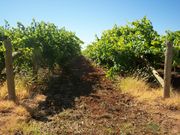
In January 2007, the Victorian Government announced that it was abandoning its proposal to build the Long Term Containment Facility at Nowingi.
It could be argued that its reasoning was that enabling legislation would have had trouble passing both houses of Parliament, with the Bracks Labor Government losing control of the reformed Legislative Council in the 2006 State Election. The parties holding the balance of power in the Legislative Council – the Nationals, the Australian Greens and Liberals all stating during the election campaign their opposition to the LTCF.
The Panel Inquiry report found the proposal to be environmentally feasible but recommended against granting approval on strategic planning grounds. Specifically because it: • Could fill too soon to provide a sustainable solution for Victoria’s Category B wastes; • Cannot be reasonably or readily expanded because of its surrounds; • Would be between two National Parks; • Would be located in high conservation value remnant vegetation which is habitat of threatened species; • Would be too distant from waste producers; and • Would be as a lesser but relevant consideration, constrained by the need to suspend construction during the breeding period of Mallee Emu-wren and Malleefowl.
The abandoning of the LTCF proposal was received with jubilation by opponents of the LTCF not only in the Mildura area and elsewhere in Victoria, but also across the border in South Australia where there were fears that in reputation, if not in substance, the toxic waste could effect the water supply via the Murray River and thereby the fruit-growing industries of the Riverland and Murraylands.
The Mildura Rural City Council and residents spent almost $2 million fighting the Government's proposal for the LTCF at Nowingi. On 10 January 2007 the Victorian Government did not rule out some form of reimbursement for the Rural City of Mildura council's legal and other costs in opposing the LTCF. "The general rule is that people bear their own costs, that is most likely to apply in this case ... but I've indicated and I am prepared to talk to the council and mayor about the whole issue of how Mildura moves forward and I'll do that," John Thwaites said.[16]
See also
- 1956 Murray River flood
- Cardross road accident
- Electoral district of Mildura
References
- ↑ 1.0 1.1 1.2 Australian Bureau of Statistics (25 October 2007). "Mildura (Urban Centre/Locality)". 2006 Census QuickStats. http://www.censusdata.abs.gov.au/ABSNavigation/prenav/LocationSearch?collection=Census&period=2006&areacode=UCL233800&producttype=QuickStats&breadcrumb=PL&action=401. Retrieved 2008-01-06.
- ↑ Mildura, Department of Planning and Community Development Mildura Rural City Council, Accessed September 27, 2007
- ↑ Westcott, Peter (1979). "Chaffey, William Benjamin (1856–1926)". Australian Dictionary of Biography. Australian National University / Melbourne University Press. http://www.adb.online.anu.edu.au/biogs/A070687b.htm. Retrieved 2007-02-22.
- ↑ 4.0 4.1 4.2 4.3 4.4 "Mildura". Sydney Morning Herald Travel. http://www.smh.com.au/news/Victoria/Mildura/2005/02/17/1108500206964.html. Retrieved 8 February 2004.
- ↑ Premier Postal History. "Post Office List". https://www.premierpostal.com/cgi-bin/wsProd.sh/Viewpocdwrapper.p?SortBy=VIC&country=. Retrieved 2008-04-11
- ↑ The Mildura Suburban Train Service McLean, Bruce Australian Railway Historical Society Bulletin, September, 1978 pp189-205
- ↑ 7.0 7.1 "Climate of Mildura". Bureau of Meteorology. http://www.bom.gov.au/vic/mildura/climate.shtml. Retrieved 7 August 2010.
- ↑ 8.0 8.1 "Monthly climate statistics". Bureau of Meteorology. http://www.bom.gov.au/climate/averages/tables/cw_076031.shtml. Retrieved 7 August 2010.
- ↑ "Country Vic first with digital TV switch". The Sydney Morning Herald. 30 June 2010. http://news.smh.com.au/breaking-news-national/country-vic-first-with-digital-tv-switch-20100630-zkgv.html. Retrieved 2 July 2010.
- ↑ Full Points Footy. "Sunraysia Football League". http://www.fullpointsfooty.net//sunraysia_football_league.htm. Retrieved 2009-04-15
- ↑ Country Racing Victoria. "Mildura Racing Club". http://www.countryracing.com.au/index.php?option=com_club_info&club=88&Itemid=80. Retrieved 2009-05-07
- ↑ Australian Harness Racing. "Mildura". http://www.harness.org.au/mildura/mildura.cfm?fromstate=vic. Retrieved 2009-05-11
- ↑ Golf Select. "Mildura". http://www.golfselect.com.au/armchair/courseView.aspx?course_id=1031. Retrieved 2009-05-11
- ↑ "Roads, ports and freight – Mildura Rail Freight Upgrade". www.doi.vic.gov.au. http://www.doi.vic.gov.au/doi/internet/Freight.nsf/AllDocs/A20CAE2D119B6DC9CA257329001895F1?OpenDocument. Retrieved 2008-06-04.
- ↑ "La Trobe University enrolment statistics". La Trobe University. http://www.latrobe.edu.au/stats/pages/statistics/enrolments.html. Retrieved 2008-10-14.
- ↑ "City seeks compo for dump fight". News Limited. 2007-01-10. http://www.news.com.au/story/0,22606,21038063-5005962,00.html. Retrieved 2007-01-10.
External links
- Official Tourism Website – Mildura
- Murray River info – Mildura
- Mildura Bureau of Meteorology Field Office
|
|||||
|
|||||||||||||||||